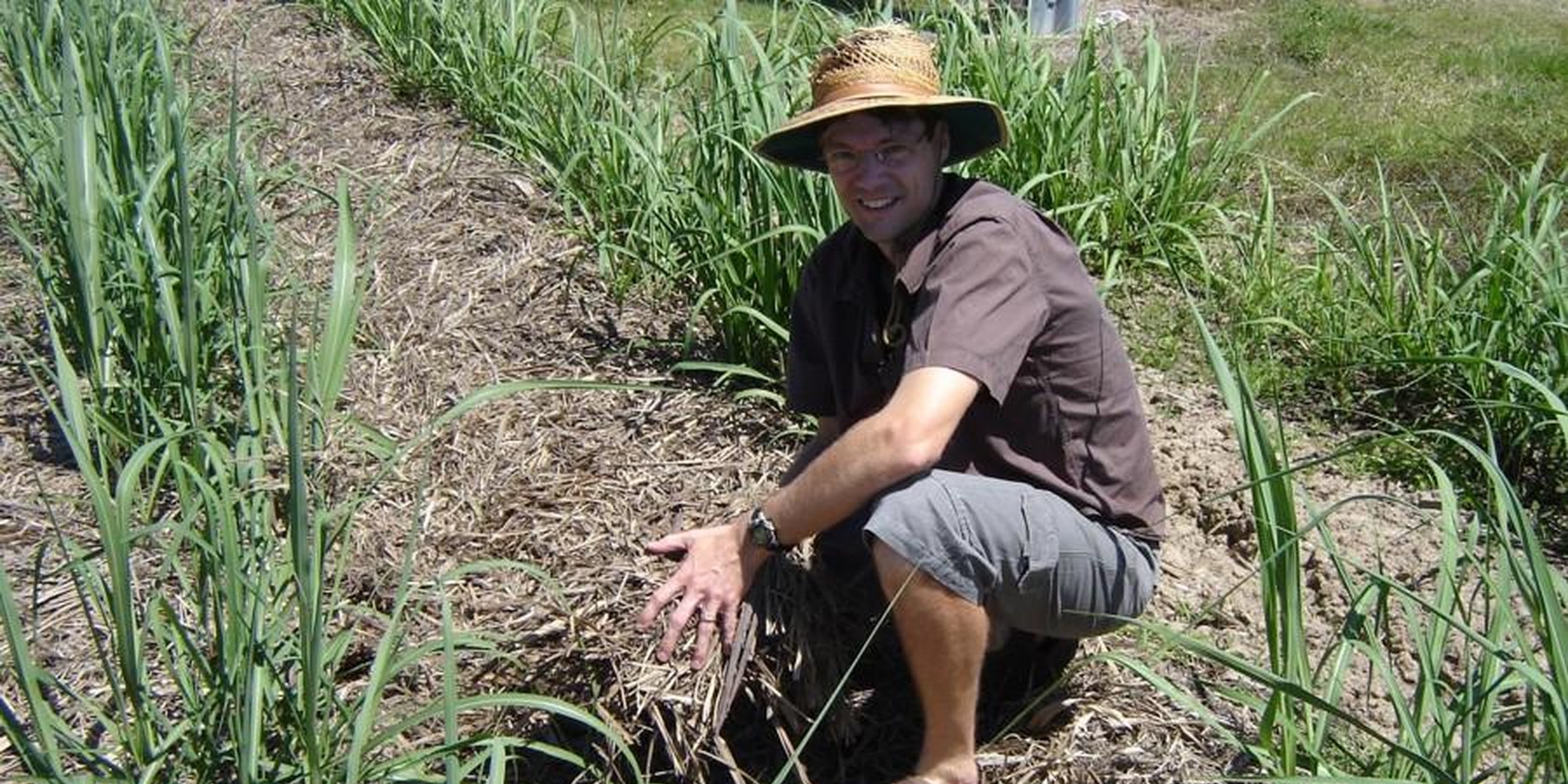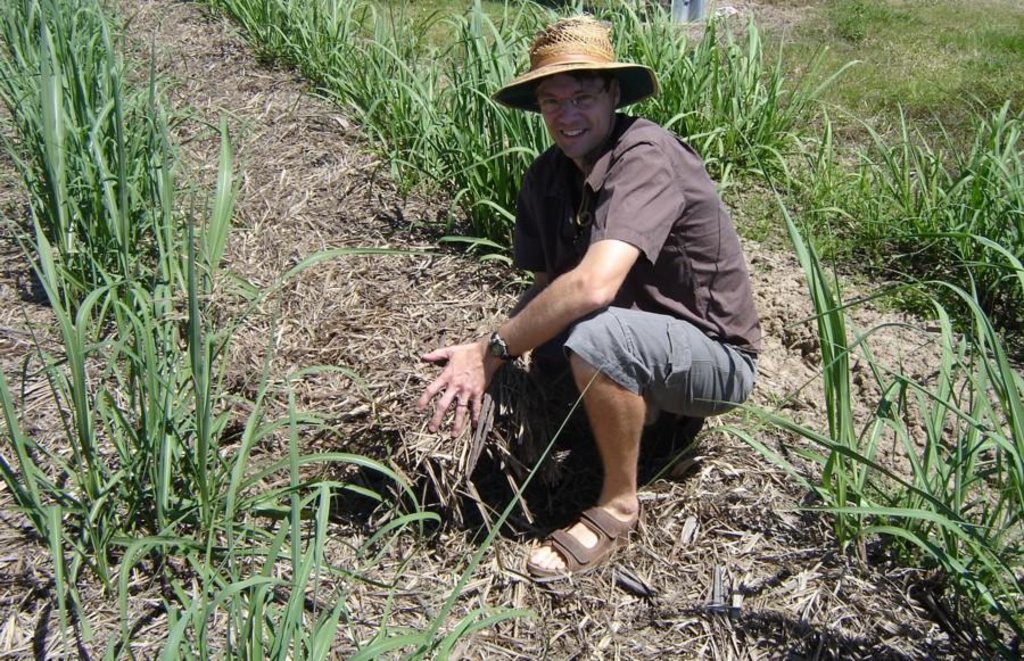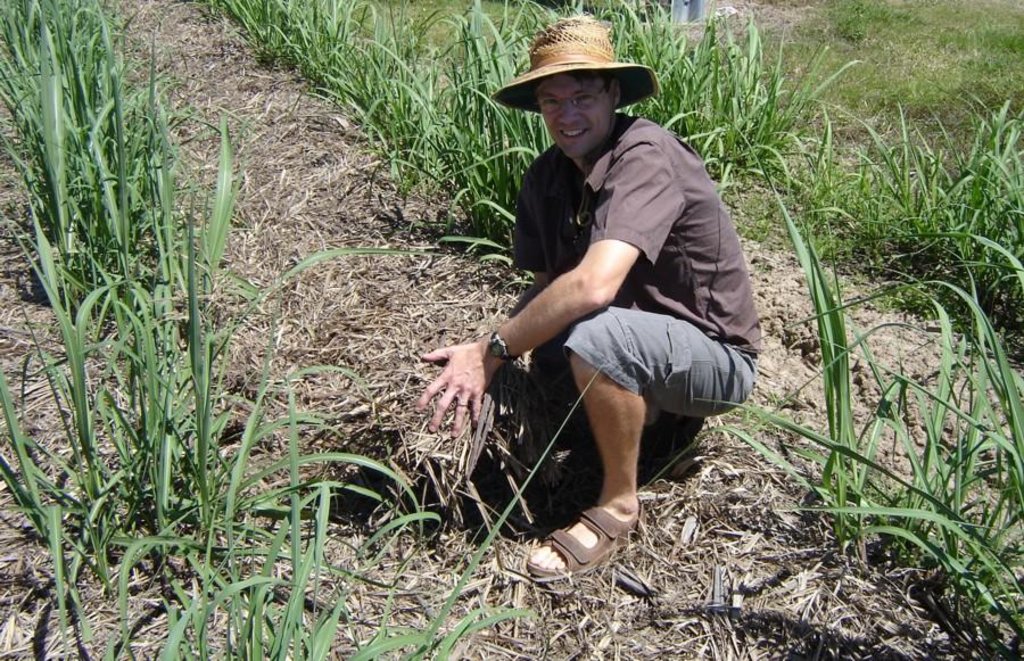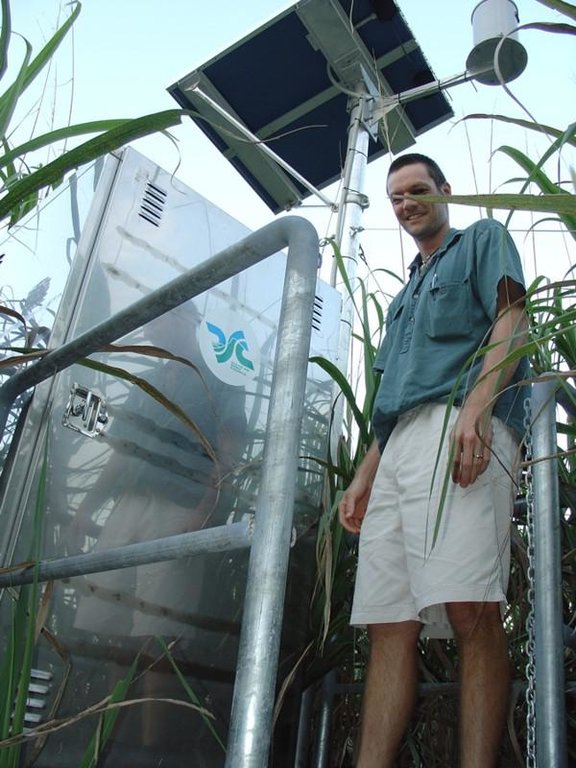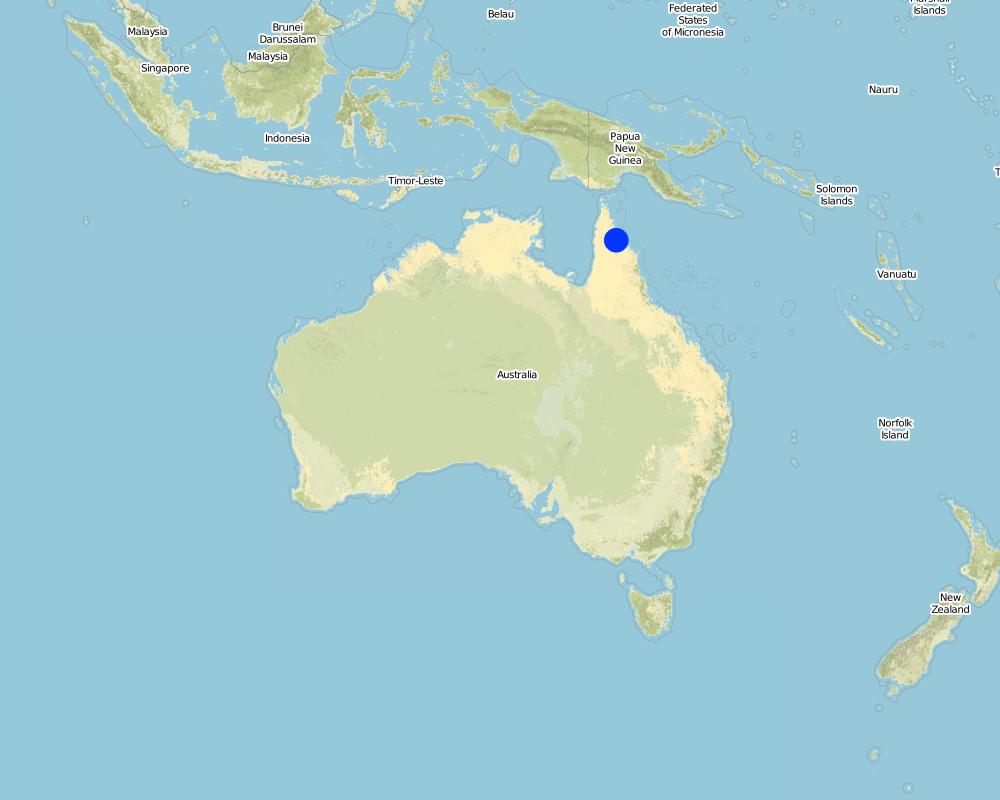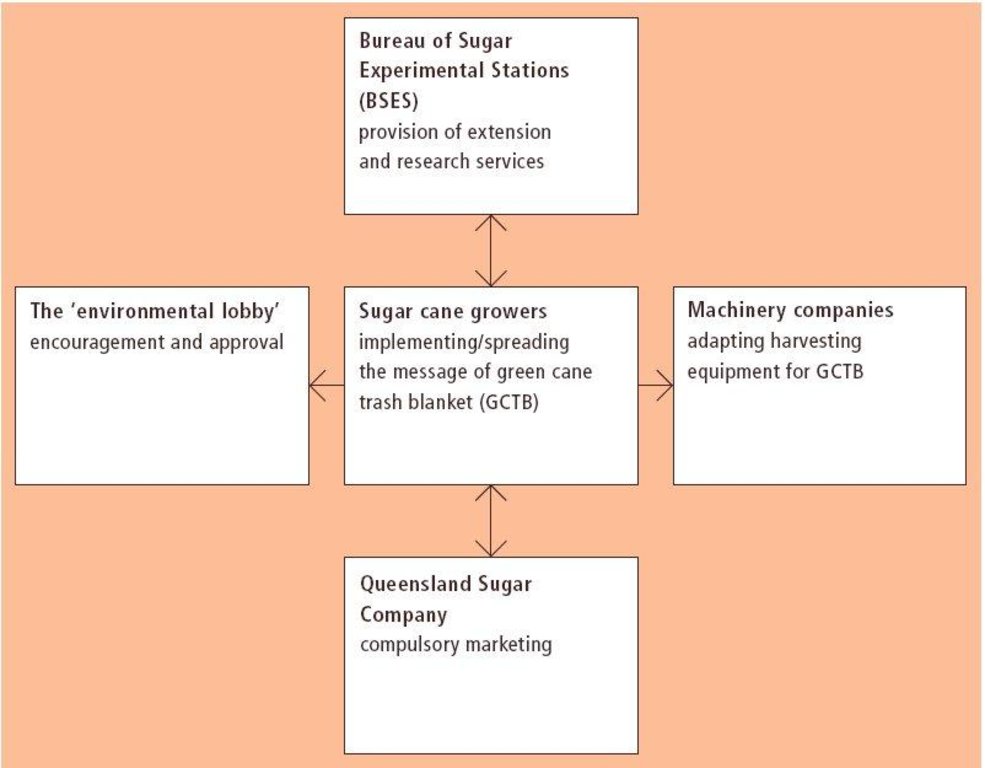The 'Triple bottom line' [ប្រទេសអូស្ត្រាលី]
- ការបង្កើត៖
- បច្ចុប្បន្នភាព
- អ្នកចងក្រង៖ Anthony J. Webster
- អ្នកកែសម្រួល៖ –
- អ្នកត្រួតពិនិត្យច្រើនទៀត៖ David Streiff, Deborah Niggli
approaches_2668 - ប្រទេសអូស្ត្រាលី
ពិនិត្យមើលគ្រប់ផ្នែក
ពង្រីកមើលទាំងអស់ បង្រួមទាំងអស់1. ព័ត៌មានទូទៅ
1.2 ព័ត៌មានលម្អិតពីបុគ្គលសំខាន់ៗ និងស្ថាប័នដែលចូលរួមក្នុងការវាយតម្លៃ និងចងក្រងឯកសារនៃវិធីសាស្ត្រផ្សព្វផ្សាយ
ឈ្មោះគម្រោងដែលបានចងក្រងឯកសារ/ វាយតម្លៃលើវិធីសាស្ត្រផ្សព្វផ្សាយ (បើទាក់ទង)
Book project: where the land is greener - Case Studies and Analysis of Soil and Water Conservation Initiatives Worldwide (where the land is greener)ឈ្មោះអង្គភាពមួយ (ច្រើន) ដែលបានចងក្រងឯកសារ/ វាយតម្លៃលើវិធីសាស្ត្រផ្សព្វផ្សាយ (បើទាក់ទង)
CSIRO (CSIRO) - ប្រទេសអូស្ត្រាលី1.3 លក្ខខណ្ឌទាក់ទងទៅនឹងការប្រើប្រាស់ទិន្នន័យដែលបានចងក្រងតាមរយៈវ៉ូខេត
អ្នកចងក្រង និង(បុគ្គលសំខាន់ៗ)យល់ព្រមទទួលយកនូវលក្ខខណ្ឌនានាទាក់ទងទៅនឹងការប្រើប្រាស់ទិន្នន័យដែលបានចងក្រងតាមរយៈ វ៉ូខេត:
បាទ/ចា៎
1.4 ការយោងមួយ (ច្រើន) ទៅលើ (កម្រង) បញ្ជីសំណួរនៃបច្ចេកទេស SLM
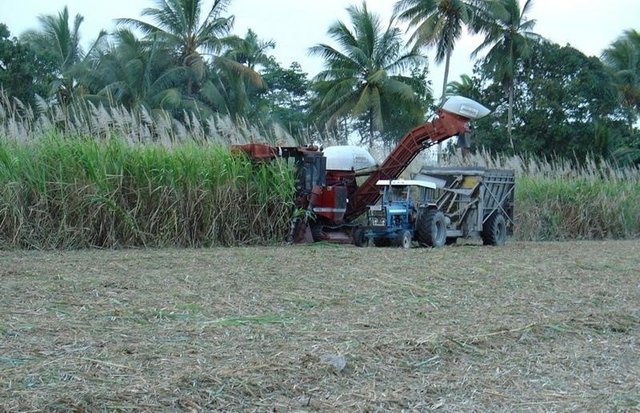
Green cane trash blanket [ប្រទេសអូស្ត្រាលី]
Elimination of burning as a pre-harvest treatment of sugar cane, and managing the resultant trash as a protective blanket to give multiple on and off-site benefits.
- អ្នកចងក្រង៖ Anthony J. Webster
2. ការពណ៌នាអំពីវិធីសាស្ត្រផ្សព្វផ្សាយ SLM
2.1 ពណ៌នាសង្ខេបខ្លីពីវិធីសាស្ត្រផ្សព្វផ្សាយ
A new expression used by agriculturalists in Australia to explain why farmers change practices: the 'triple bottom line' implies economic, environmental and social concerns.
2.2 ពណ៌នាលម្អិតពិវិធីសាស្ត្រផ្សព្វផ្សាយ
ពណ៌នាលម្អិតពិវិធីសាស្ត្រផ្សព្វផ្សាយ:
Aims / objectives: A fundamental change has occurred in farming practice amongst sugar cane growers in the tropics of far north Queensland. Where it was once standard practice to burn cane before harvest (defoliating green canes for easier harvest), tradition has been turned on its head and now almost no-one burns. Instead a 'green cane trash blanket' system has developed, with multiple benefits and few or no drawbacks. There has been no official campaign or punitive sanctions imposed, no enticing financial incentives offered or charismatic environmental leadership - just a quiet technological revolution, based on the principles of the 'triple bottom line' (TBL).
Methods: TBL has recently emerged into common usage amongst agriculturalists in Australia. Rather than attributing farmers' actions as simple responses to economic stimuli ('the bottom line') TBL is a framework that helps explain the complexity of factors that influence farmers to modify their practices. TBL suggests that farmers do indeed respond to money, but also to environmental concerns, and furthermore to social considerations as well. This gives credit to farmers for being responsible stewards of the land. In this particular case, the transition in technology started in 1974, when sugar cane growers in the far north of Queensland were simply unable to burn their cane prior to harvest because of the exceptionally heavy rains. Instead, they had to harvest wet - and green. The technical implications were first, a slower harvest speed because machinery had to cope with a greater load of biomass, and second, a thick residual blanket of trash that covered the soil. The multiple benefits of mulching were recognised by a few growers, who then continued to harvest green cane. Non-burning spread - a technology now described as the 'green cane trash blanket'- until almost every grower adopted it within one generation. While the extension service has supported the transition, growers themselves tookthe initiative to change. There are indeed small financial benefits, chiefly in terms of reduced overall input costs, but growers have simultaneously been motivated by social and environmental considerations. Burning has come to be considered anti-social: a dirty practice, carrying the danger of fire spreading outside the targeted fields. Neither is it a pleasant task, requiring help of family and friends, often at inconvenient times.
Other important information: From an environmental perspective, the benefits of trash mulch are tangible in terms of improved soil quality, and reduced erosion rates. And, equally important, the end result is reduced damage to the close-by Great Barrier Reef with its sediment-sensitive living coral.
The triple bottom line(TBL) is an expression which has evolved in Australia to help explain why farmers act as they do. Its three components of economics, the environment and social aspects cover the considerations that cause farmers to modify technologies. TBL implicitly gives credit to farmer for being sensitive to multiple external signals. In this case the change in practice is from burning sugar cane to harvesting it green in Far North Queensland. This is a case where emerging conservation-friendly farmer practice and the goals of the environmental lobby have neatly coincided.
2.3 រូបភាពនៃវិធីសាស្ត្រផ្សព្វផ្សាយ
2.5 ប្រទេស/តំបន់/ទីតាំងកន្លែង ដែលវិធីសាស្ត្រផ្សព្វផ្សាយត្រូវបានអនុវត្តន៍
ប្រទេស:
ប្រទេសអូស្ត្រាលី
តំបន់/រដ្ឋ/ខេត្ត:
Queensland
Map
×2.6 កាលបរិច្ឆេទនៃការចាប់ផ្តើម និងបញ្ចប់នៃវិធីសាស្រ្តផ្សព្វផ្សាយនេះ
សូមបញ្ជាក់ឆ្នាំដែលបានបង្កើតឡើង:
1974
2.7 ប្រភេទនៃវិធីសាស្ត្រផ្សព្វផ្សាយ
- ក្រុមប្រពៃណី/ក្រុមជនជាតិភាគតិច
2.8 គោលបំណង/ទិសដៅសំខាន់នៃវិធីសាស្ត្រផ្សព្វផ្សាយ
The Approach focused on SLM only
(1) Demonstration and dissemination. (2) The spread of non-burning practices, specifically the 'green cane trash blanket' technology to promote sustainable and environmentally friendly sugar cane production. (3) Indirectly: to satisfy social concerns associated with burning of sugar cane.
The SLM Approach addressed the following problems: (1) Anti-social farming practice of burning sugar cane which also has negative environmental impacts, both in situ, and offsite in the coral reef. (2) Resistance to change in traditional farming practice.
2.9 លក្ខខណ្ឌអនុញ្ញាត ឬរារាំងការអនុវត្តន៍បច្ចេកទេសដែលស្ថិតនៅក្រោមវិធីសាស្រ្តផ្សព្វផ្សាយ
សង្គម/វប្បធម៌/ និងតម្លៃនៃសាសនា
- រារាំង
traditional way of doing things/social resistance
Treatment through the SLM Approach: demonstration and dissemination of benefits
ភាពអាចរកបាននៃធនធានហិរញ្ញវត្ថុ និងសេវាកម្ម
- រារាំង
Higher costs of harvesting (a small premium charged by contractors per tonne of green cane harvested).
Treatment through the SLM Approach: These costs are offset by lower tillage input, no costs associated with burning, and lower inputs of agrochemicals also.
ក្របខណ្ឌច្បាប់ (សិទ្ធិកាន់កាប់ដីធ្លី កម្មសិទ្ធីប្រើប្រាស់ដីនិងទឹក)
- អំណោយផល
- រារាំង
ចំណេះដឹងស្តីពី SLM និងការទទួលបានការគាំទ្រផ្នែកបច្ចេកទេស
- រារាំង
Harvesting machines at first were not so well able to cope with the greater biomass to be harvested.
Treatment through the SLM Approach: Manufacturers developed higher capacity harvesters.
3. ការចូលរួម និងតួនាទីរបស់ភាគីពាក់ព័ន្ធ
3.1 អ្នកពាក់ព័ន្ធដែលបានចូលរួមក្នុងវិធីសាស្ត្រផ្សព្វផ្សាយ និងតួនាទីរបស់ពួកគេ
- អ្នកប្រើប្រាស់ដីក្នុងតំបន់/សហគមន៍
There is no difference between men and women in principle, though de facto most growers are male.
- រដ្ឋាភិបាលថ្នាក់ជាតិ (អ្នករៀបចំផែនការ អ្នកសម្រេចចិត្ត)
politicians (govt. agencies)
- environmentalists
3.2 ការចូលរួមរបស់អ្នកប្រើប្រាស់ដីក្នុងតំបន់/ សហគមន៍ក្នុងតំបន់ក្នុងដំណាក់កាលផ្សេងគ្នានៃវិធីសាស្រ្តផ្សព្វផ្សាយ
| ការចូលរួមរបស់អ្នកប្រើប្រាស់ដីក្នុងតំបន់/សហគមន៍ក្នុងតំបន់ | សូមបញ្ជាក់នរណាត្រូវបានចូលរួម ព្រមទាំងពណ៌នាសកម្មភាពទាំងនោះ | |
|---|---|---|
| ការចាប់ផ្តើម/ការលើកទឹកចិត្ត | គំនិតផ្តួចផ្តើមដោយខ្ឡួនឯង | starting up the practice; starting up the practice of green cane trash blanket (GCTB) |
| ការរៀបចំផែនការ | គ្មាន | |
| ការអនុវត្តន៍ | អន្តរកម្ម | spreading the word; growers spreading the word, support by extension services |
| ការត្រួតពិនិត្យ និងវាយតម្លៃ | អន្តរកម្ម | growers joining hands with research; formal and informal disseminations of observations |
| Research | អន្តរកម្ម | growers joining hands with research. Quantifying benefits short, long term and downstream |
3.3 គំនូសបំព្រួញ (ប្រសិនបើមាន)
ការពណ៌នា:
Institutional framework Inter-relationships between sugar cane growers and other stakeholders.
3.4 ការសម្រេចចិត្តលើការជ្រើសរើសបច្ចេកទេស SLM
សូមបញ្ជាក់តើអ្នកណាជាអ្នកបានសម្រេចចិត្តក្នុងការជ្រើសរើសបច្ចេកទេសដើម្បីយកមកអនុវត្តន៍:
- អ្នកប្រើប្រាស់ដីដោយខ្លួនឯងផ្ទាល់ (គំនិតផ្តួចផ្តើមដោយខ្លួនឯង)
ចូរពន្យល់:
sugar cane growers
Decisions on the method of implementing the SLM Technology were made by by land users* alone (self-initiative / bottom-up)
4. ជំនួយបច្ចេកទេស ការកសាងសមត្ថភាព និងការគ្រប់គ្រងចំណេះដឹង
4.1 ការកសាងសមត្ថភាព/ បណ្តុះបណ្តាល
តើវគ្គបណ្តុះបណ្តាលបានផ្តល់ឱ្យអ្នកប្រើប្រាស់ដី/អ្នកពាក់ព័ន្ធផ្សេងៗទៀតដែរឬទេ?
ទេ
4.2 សេវាផ្តល់ប្រឹក្សាយោបល់
តើអ្នកប្រើប្រាស់ដីបានទទួលនូវសេវាផ្តល់ប្រឹក្សាដែរ ឬទេ?
បាទ/ចា៎
សូមបញ្ជាក់ប្រសិនបើសេវាកម្មប្រឹក្សាយោបល់ត្រូវបានផ្តល់ឱ្យ:
- នៅលើដីរបស់អ្នកប្រើប្រាស់ដី
ពណ៌នា/ពន្យល់:
Name of method used for advisory service: green cane trash blanket (GCTB) system; Key elements: visits, Field days, publications; (1) Advisory service was carried out through: Bureau of Sugar Experimental Stations (BSES).(2) Advisory service was carried out through: Bureau of Sugar Experimental Stations (BSES).
4.3 ការពង្រឹងសមត្ថភាពស្ថាប័ន (ការអភិរឌ្ឍន៍អង្គភាព)
តើស្ថាប័នទាំងអស់ត្រូវបានបង្កើតឡើង ឬពង្រឹងសមត្ថភាពតាមរយៈវិធីសាស្ត្រផ្សព្វផ្សាយដែរ ឬទេ?
- ទេ
4.4 ការត្រួតពិនិត្យ និងវាយតម្លៃ
តើការត្រួតពិនិត្យ និងវាយតម្លៃគឺជាផ្នែកមួយនៃវិធីសាស្ត្រដែរឬទេ?
បាទ/ចា៎
មតិយោបល់:
Technical aspects were ad hoc monitored by land users through observations
There were None changes in the Approach as a result of monitoring and evaluation: Not applicable.
4.5 ការស្រាវជ្រាវ
តើការស្រាវជ្រាវ គឺជាផ្នែកមួយនៃវិធីសាស្រ្តដែរឬទេ?
បាទ/ចា៎
បញ្ជាក់ប្រធានបទ:
- សេដ្ឋកិច្ច/ទីផ្សារ
- បរិស្ថានវិទ្យា
- បច្ចេកវិទ្យា
សូមផ្តល់ព័ត៌មានបន្ថែមទៀតឱ្យបានលម្អិត និងចង្អុលបង្ហាញនរណាដែលបានធ្វើការស្រាវជ្រាវ:
There has been some ad hoc research carried out on technical parameters by both the BSES as well as CSIRO.
5. ថវិកា និងសម្ភារៈឧបត្ថម្ភពីខាងក្រៅ
5.1 ថវិកាប្រចាំឆ្នាំសម្រាប់ផ្សព្វផ្សាយ SLM
មតិយោបល់ (ឧ. ប្រភពសំខាន់នៃមូលនិធិ/ម្ចាស់ជំនួយចំបង):
Approach costs were met by the following donors: government (national government, Bureau of Sugar Experiment Stations): 20.0%; other (growers themselves): 80.0%
5.2 ការគាំទ្រផ្នែកហិរញ្ញវត្ថុ / សម្ភារៈដែលបានផ្តល់ទៅឱ្យអ្នកប្រើប្រាស់ដី
តើអ្នកប្រើប្រាស់ដីបានទទួលការគាំទ្រផ្នែកហិរញ្ញវត្ថ/សម្ភារៈសម្រាប់ការអនុវត្តន៍បច្ចេកទេសដែរឬទេ:
បាទ/ចា៎
ប្រសិនបាទ/ច៎ា សូមបញ្ជាក់ប្រភេទ(ច្រើន)នៃការគាំទ្រ លក្ខខណ្ឌ និងអ្នកផ្តល់ឱ្យ(ច្រើន):
By government (national government, Bureau of Sugar Experiment Stations)
5.3 សូមបញ្ជាក់ពីធាតុចូលត្រូវបានផ្តល់បដិភាគ (រួមទាំងកម្លាំងពលកម្ម)
- គ្មាន
ប្រសិនបើកម្លាំងពលកម្មធ្វើដោយអ្នកប្រើប្រាស់ដី តើវាជាធាតុចូលដ៏សំខាន់មួយដែរ ឬទេ:
- ដោយស្ម័គ្រចិត្ត
មតិយោបល់:
Farmers themselves provide labour
There are no subsidies connected to GCTB. Australia does not subsidise its sugar cane growers and sugar is sold at the world price.
5.4 ឥណទាន
តើឥណទានដែលបានផ្តល់នៅក្រោមវិធីសាស្ត្រផ្សព្វផ្សាយសម្រាប់សកម្មភាព SLM នេះយ៉ាងដូចម្តេច?
ទេ
6. ការវិភាគរកផលប៉ះពាល់ និងសេចក្តីសន្និដ្ឋាន
6.1 ផលប៉ះពាល់នៃវិធីសាស្ត្រផ្សព្វផ្សាយ
តើវិធីសាស្ត្រផ្សព្វផ្សាយជួយអ្នកប្រើប្រាស់ដីដើម្បីអនុវត្តន៍ និងថែទាំបច្ចេកទេស SLM?
- ទេ
- បាទ/ច៎ា បន្តិចបន្តួច
- បាទ/ច៎ា ជាមធ្យម
- បាទ/ច៎ា បានខ្លាំង
Considerable: nutrient losses reduced, erosion reduced, organic matter built up, etc.
Did other land users / projects adopt the Approach?
- ទេ
- បាទ/ច៎ា បន្តិចបន្តួច
- បាទ/ច៎ា ជាមធ្យម
- បាទ/ច៎ា បានខ្លាំង
The 'triple bottom line' is probably active throughout Australia in influencing farmers??? decisions.
6.3 សកម្មភាពផ្សព្វផ្សាយដែលប្រកបដោយចីរភាព
តើអ្នកប្រើប្រាស់ដីអាចធ្វើឱ្យមានចីរភាពនូវអ្វីដែលត្រូវបានអនុវត្តន៍តាមរយៈវិធីសាស្ត្រផ្សព្វផ្សាយដែរឬទេ(ដោយពុំមានការគាំទ្រពីអ្នកខាងក្រៅ)?
- បាទ/ចា៎
ប្រសិនបាទ/ច៎ា សូមរៀបរាប់ថាធ្វើយ៉ាងម៉េច:
By definition this is sustainable: it is an internal mechanism amongst farmers.
6.4 ភាពខ្លាំង/ គុណសម្បត្តិនៃវិធីសាស្ត្រផ្សព្វផ្សាយ
| ភាពខ្លាំង/ គុណសម្បត្តិ/ ឱកាស ទស្សនៈរបស់បុគ្គលសំខាន់ៗ |
|---|
| Farmers take the responsibility of choosing a land management practice that has a positive 'triple bottom line': environmental, economic and social benefits. (How to sustain/ enhance this strength: Support awareness raising and give appreciation to the on-site and off-site benefits; acknowledge sugar produced under this system an environmentally friendly and economic product.) |
| Has successfully stimulated the spread of the green cane trash blanket system. (How to sustain/ enhance this strength: Outsiders should continue to support farmers' multiple concerns.) |
| Sugar cane growing has previously had a bad environmental and social reputation, especially here, close to the Great Barrier Reef, which is a World Heritage Site. This change in practice, resulting from the 'triple bottom line' has changed the reputation of sugar cane growers. (How to sustain/ enhance this strength: Make this public.) |
6.5 ភាពខ្សោយ/ គុណវិបត្តិនៃវិធីសាស្ត្រ និងរកដំណោះស្រាយ
| ភាពខ្សោយ/ គុណវិបត្តិ/ ហានិភ័យក្នុងទស្សនៈរបស់បុគ្គលសំខាន់ៗ | តើបច្ចេកទេសទាំងនោះបានដោះស្រាយបញ្ហាដូចម្តេច? |
|---|---|
| The fact that farmers are responsive to environmental and social as well as economic stimuli is covered up by conventional thinking that 'only money matters to them'. | Investigation and documentation of the 'triple bottom line' is required. |
7. ឯកសារយោង និងវេបសាយ
7.1 វិធីសាស្ត្រ/ ប្រភពនៃព័ត៌មាន
- តាមការចុះទីវាល ការស្រាវជ្រាវនៅទីវាល
- ការសម្ភាសន៍ជាមួយអ្នកប្រើប្រាស់ដី
ការតភ្ជាប់ និងម៉ូឌុល
ពង្រីកមើលទាំងអស់ បង្រួមទាំងអស់ការតភ្ជាប់

Green cane trash blanket [ប្រទេសអូស្ត្រាលី]
Elimination of burning as a pre-harvest treatment of sugar cane, and managing the resultant trash as a protective blanket to give multiple on and off-site benefits.
- អ្នកចងក្រង៖ Anthony J. Webster
ម៉ូឌុល
គ្មានម៉ូឌុល


